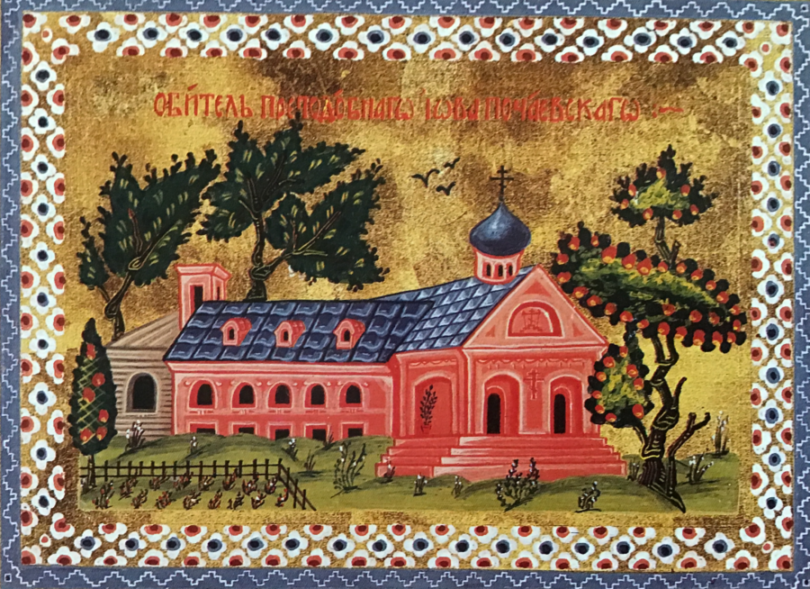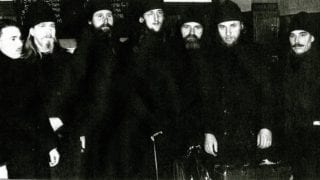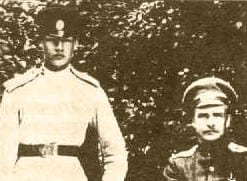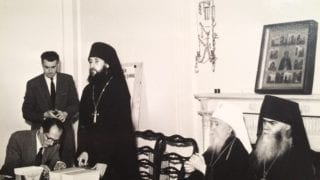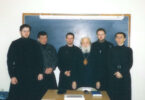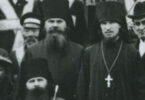Introduction
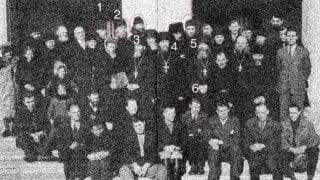
St. Job of Pochaev Monastery. The second half of 1948. Marked future: 1) Mon. Nyphont; 2) Priestmonk Barnabas, 3) Abbot Joasaph, 4) Mon. Antonii, 5) Hierod. Barlaam, 6) Archim. Vladimir. Photo: VGE, 5, 1995
This article contains brief biographies of the inhabitants of the Monastery of St. Job in Munich who had moved to Holy Trinity Monastery in Jordanville. It should be said at the outset that there is much in common between our monasteries, since they are branches of the same root. The Monastery St. Job of Pochaev and Holy Trinity Monastery have their beginning in the Monastery of St. Job in the Carpathian Mountains which was founded in 1923 by Archimandrite (later Archbishop) Vitalii (Maximenko). Prior to the Revolution he headed the printing press at the Pochaev Lavra, which was known throughout all Russia. Thus both of our monasteries trace their origins to the glorious and ancient Pochaev Lavra. This spiritual continuity is demonstrated wonderfully in the icon of Venerable Job of Pochaev written by the famous iconographer of the Russian diaspora, Archimandrite Kiprian, in which the saint is depicted against the background of all four monasteries.
The Pochaev Lavra became renowned for the activities of its great saint, the Venerable Job of Pochaev, who had founded the monastery print shop, where service books and books on religious education were printed. Bequeathed by St Job, this labor was continued by the monasteries in the Carpathian Mountains, Munich, Jordanville, and Montreal, which established print shops at their founding. The ministry of the Monastery of St. Job at Vladimirovo in Presov Rus’ was of a missionary nature in many ways. Besides performing worship services and working for the provision of the monastery’s livelihood, the brotherhood ministered to neighboring villages and carried out religious education work among the population of the Presov Region. The monastery became a bulwark in the struggle against the Unia, which had been imposed upon the people, and in the rebirth of Orthodoxy in the Carpathian Mountains. The monastery’s spiritual influence extended very quickly far beyond the Carpathian region and spread to the entire emigration. The name change of the newspaper put out by the monastery from Pravoslavnaia Karpatskaia Rus’ to Pravoslavnaia Rus’ is a clear witness to this. The establishment of pastoral courses was planned at the monastery. A building was built and a program was developed. However, due to changed political circumstances, these plans were not fated to be realized. The monastery soon became a pilgrimage destination for the entire Russian diaspora. Once the activity of the Monastery of St. Job in the Carpathian Mountains ceased most of the brotherhood went first to Germany, then to Switzerland, and finally to the United States to join the inhabitants of Holy Trinity Monastery in Jordanville. Those of the brotherhood who remained in Germany gathered around Archimandrite Job (Leontiev) who founded a new Monastery of St. Job in Obermenzing, a suburb of Munich. With their common origin going back to the Monastery of St. Job in the Carpathian Mountains and, beyond that, to the Pochaev Lavra, our monasteries have much in common. We already mentioned the presence of a print shop at both monasteries. Both monasteries engage in active educational work among the Russian diaspora and missionary work among the heterodox. Both monasteries soon became pilgrimage centers where worshippers gather both in the United States and in Europe. They both bring together the special veneration of St. Job of Pochaev. The lower church at Holy Trinity Monastery is dedicated to him, and he is the protector of the monastery press. Other than on the saint’s feast day he is honored by a public commemoration on the first Sunday in September. With this brief introduction, we wish to emphasize the historical and spiritual relationship of our monasteries, and the mutual characteristics of their ministry. Thus it is not surprising that most of the inhabitants of the Monastery of Job joined Holy Trinity Monastery specifically.
A Brief Historical Digression
There were several reasons for the move to America. Postwar Europe was in ruins and impoverished. However, in our view the main factor was that for many Russian immigrants Germany appeared as a nation too close to the iron curtain that they feared, and many of them, including some of the monastery’s inhabitants, strove to go overseas. Archimandrite Job did not stand in the way and many of the monastics left for the United States and other countries. [1] A.A. Sollogub, Russkaia Pravoslavnaia Tserkov’ Zagranitsei [The Russian Orthodox Church Outside Russia, 1918-1968]. Russian Spiritual Mission in Jerusalem. But there was also another purely ecclesiastical reason. By 1949 Holy Trinity Monastery in Jordanville had become an important missionary center in America which was drawing attention not only of the Russian emigration, but according to Vladyka Averkii was bringing delight to local Americans. [2] Pravoslavnaia Rus’ [Orthodox Russia] 1949:4, p. 15. To help such important work of the entire Church seven monks from the Munich Monastery of St. Job were sent to Holy Trinity Monastery in Jordanville in January of 1949. These inhabitants had done much work for their monastery. They proved themselves to be hardworking monks and excellent specialists in areas necessary for the monastery’s upkeep, such as printing, gardening, and metalworking, but, most importantly, they were monks by calling. It is noteworthy that a moleben was served and a farewell address was said by Archimandrite Averkii, who came to live at Holy Trinity Monastery a few years later and was its superior for many years.
It should be noted that work on their biographies involved definite difficulties. It is apparent that all who will be mentioned were “notable” in various degrees regarding their participation in church life, so consequently, their lives are reflected in different ways in the sources. Not all of them were monastics. We find among them both an archbishop and a layman. Not all of them devoted their lives completely to Holy Trinity Monastery. Some of them remained there till the end, while others stayed there for a while and their basic activity took place outside the monastery’s walls. Some had important church positions while others were humble toilers or simply neighbors of the monastery. Consequently, we have extensive biographies for some, just a few lines for others, and no information for still others. This explains why this report gives some individuals a great deal of space while others are mentioned in brief statements. The report is arranged hierarchically, with an archbishop’s biography first, followed by clergy biographies, then those of simple monks, and, finally, those of laymen.
The report offered to you is not simply descriptive. As we worked on it our task was not merely to acquaint our audience with the lives of certain individuals. I wished to show the role that was played by the former inhabitants of the Monastery of St. Job of Pochaev both in the life of Holy Trinity Monastery and in the entire Russian Church Outside Russia.
Archbishop Serafim of Caracas and Venezuela (Svezhevskii)
Konstantin Nikolaevich Svezhevskii was born on August 14, 1899 [3] All dates are according to the new calendar. in Proskurov in the Kamenets-Podolsk Province. In May of 1909 he entered the Grand Duke Konstantin Konstantinovich Military School in Odessa, which he completed in 1916 and was accepted into the Sergius Artillery School, also in Odessa, completing it in February 1917. That same year he was assigned to the active army at the Romanian front, arriving there on March 2, 1917 the day of the emperor’s abdication). He remained at the front until January 1918, when he returned home with a group of soldiers. He fought courageously and was granted a military award – the Stanislav Order of the Third Degree. At the time the Svezhevskii family was living in Rostov the Great, where his father was military chief. Soon the family moved to Ekarinoslav (currently Dnepropetrovsk). At that time the White Movement was arising in Russia’s South, and Konstantin Nikolaevich joined it almost immediately. In August 1918 he headed for Novocherkassk, where he joined the Volunteer Army and was assigned to the “Officer” armored train. As part of the train crew he participated in the taking of Armavir. A month and a half later he took part in military action near Stavropol. After the Bolsheviks were routed near Stavropol he continued fighting in the Kuban Division of General Pokrovskii. This division was part of General Wrangel’s army which was advancing toward Tsaritsyn (currently Volgograd). On the way to Tsaritsyn Konstantin Nikolaevich was stricken with typhus and was sent to a hospital in Novocherkassk. Upon recovery he returned to his unit in Tsaritsyn. In October 1919 he was sent to an officers’ school in Sevastopol, and then into General Morozov’s division, which maintained Perekop’s defense. He took part in battles in the Northern Tauride with this division. In November 1920 he left Russia forever with General Wrangel’s army. In the initial years of emigration Konstantin Svezhevskii changed many places. These included Constantinople, the island of Lemnos, Bulgaria, and Belgium. During World War II he moved from Brussels to Berlin, where he joined the Russian Liberation Army of General Andrei Andreevich Vlasov. Amidst all of life’s storms and turmoil Konstantin’s heart was always drawn to the Church, to monasticism. Thus, it is not surprising that as soon as Archimandrite Job (Leontiev) established the new Monastery of St. Job of Pochaev Konstantin immediately joined the brotherhood. In August 1947 he was tonsured into the mantiya as Serafim in honor of St. Serafim of Sarov. On September 10, 1948, Metropolitan Anastassii ordained the Monk Serafim hierodeacon. And in January 1949 Fr. Serafim moved to Holy Trinity Monastery in Jordanville, where he entered the Holy Trinity Seminary. Upon graduation he received diploma number one. In 1952 Archbishop Vitalii (Maksimenko) ordained Hierodeacon Serafim hieromonk. Two years later, in 1956, he was elevated by the same hierarch to hegumen, and in the same year to archimandrite by Bishop Vitalii (Ustinovich). According to the decision of the Bishops’ Synod of the Russian Orthodox Church Outside Russia Archimandrite Serafim was chosen to head the Diocese of Venezuela. His consecration as Bishop of Caracas and Venezuela took place in March of 1957.
Vladyka Serafim arrived in Caracas on April 20, 1957. It is noteworthy that the first service that he celebrated in his new diocese was a paschal one. The Orthodox Church in Venezuela acquired its first archpastor in the person of Vladyka Serafim. Setting up the diocese took much effort. The spiritual state of the Venezuelan flock was lamentable due to the cruel storms of the twentieth century. The Revolution and the Civil War deprived many of their fortunes, social position, and spiritual tranquility. The terrible hard times dispersed Russian people throughout different countries, and many withdrew from the Church, carried away by the pursuit of worldly well-being. Concern for the acquisition of material blessings cooled the concern for the Orthodox raising of children. For many avoidances of church attendance and fasting became a regular practice, leading to the toppling of family foundations on a wide scale. This situation was intensified as well by the activities of the USSR secret services working toward the dissolution of the Russian emigration. The Church in Venezuela laid great hopes upon the new bishop. The parishioners expected him to teach, instruct, correct, and enliven their indifference through the word of archpastoral instruction, inflaming them with the power of love and attracting them to good works. Vladyka fully justified the hopes of his flock. Having gone through the monastery school he came with a firm train of thought and an inexhaustible supply of heartfelt warmth. Under his archpastoral leadership the Russian Church in Venezuela became a reliable spiritual harbor open to all. Vladyka Serafim led the diocese with incredible exuberance and energy. The first Diocesan Assembly was called together on June 23, 1957, under his chairmanship. Concerned about worship services, he made sure that they were conducted according to the ustav and magnificently. Vladyka gave special attention to the youth. His greatest concern was to attract the young to participate in the services. He strove for the youth not to merely serve in the altar or sing or read at the kliros but to understand what was taking place in the church, to love it and take care of it. He himself taught the Saturday School, held discussions with the students, led the studies of the Vladimir Circle, and visited his flock at home. Vladyka noted very quickly that the youth’s knowledge of Holy Scripture was very poor and dedicated himself to work on its explanation. He compiled numerous brief commentaries on various places in the Bible and conducted regular discussions, explaining the meaning of liturgical texts, demanding that his subordinate clergy do the same. In his sermons Vladyka Serafim emphasized that in the era of the total triumph of evil we cannot withstand its destructive power without God’s help, for which we must strictly observe divine commands.
Sisterhoods were established in all parishes to take care of church appearance and furnishings. Women’s charity committees were in charge of charitable activities. Bishop Serafim didn’t leave the elderly and infirm of his flock uncared for. St. Nicholas Parish acquired and equipped a home for the elderly, and a burial fund was set up in Caracas.
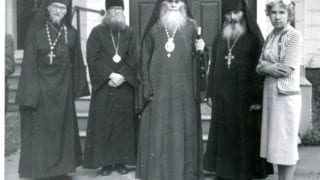
Bp. Seraphim is the second from the left. On his right is Fr. Antonii (Iamshchikov), then Bp. Averkii, Fr. Joseph (Kolos) and Mrs Sophia Freesk. Aug. 23, 1961, St. Nicholas church In Pougkeepsie, NY
From 1968 to 1978 Vladyka Serafim headed the Diocese of Brazil as well. In spite of his advanced age and a recent illness he was an indefatigable traveler and could serve as an example for his younger brethren. He made it a rule to visit all parishes in Brazil regularly, some of them quite remote, requiring bus rides of twenty or twenty-five hours. He did this without any special invitations or ceremony. And each year he would go to the United States on diocesan matters.
In 1962 Vladyka Serafim consecrated Bishop Peter of Astoria in New York for the Greek Old Calendarists contrary to instructions by the Church authorities. In the summer of 1964 he came to San Francisco in connection with the lamentable trial of Archbishop John. In the meantime his health took a turn for the worse. He underwent a serious illness in 1970.
In 1977 the Bishops’ Synod of the Russian Orthodox Church Outside Russia ruled to split the diocese into one for Venezuela and one for Brazil, with Archbishop Serafim remaining in the Venezuelan See. Bishop Nikandr (Paderin) was appointed to the Diocese of Brazil. The year 1977 marked twenty years of Vladyka’s service as hierarch. He had labored in the Brazilian Diocese for ten years and in the Venezuelan one for twenty. On August 31, 1977 he left for Caracas, sent off by his Brazilian flock which had come to love him intensely. During the last two months of his stay in Brazil he served everywhere, visited all the parishes, and bade farewell to everyone. In 1983 Vladyka Serafim retired, having been in the Venezuelan See for a total of 27 years. In retirement he lived in the United States at Novo Diveevo Monastery. He would visit Holy Trinity Monastery in Jordanville and attend graduation ceremonies at Holy Trinity Seminary, always with joy. Archbishop Serafim reposed on September 13, 1996 and was buried at Holy Trinity Monastery he so loved.
While nurturing two dioceses, Vladyka Serafim, in spite of all the difficulties of his lofty service, amazed everyone by his lightness, tirelessness, and the spiritual energy that never left him. This bright kindness, his unusual personal modesty, wise long-suffering, peacefulness, and true Christian love to all persons was never absent. As a profound ascetic, he was full of Christian love for everyone, which attracted the hearts and love of his flock.
Archimandrite Vladimir (Sukhobok)
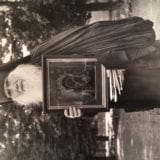
Fr. Vladimir was a comforter of the whole Russian diaspora holding his mail and an icon to bless someone. His death left a void in HTM
Vasilii Sukhobok lived at Holy Trinity Monastery for 39 years in the world. He found himself in Germany during the Second World War. He studied at a Russian high school and entered St. Job Monastery in Munich. He came to the United States in 1949 with the group from St. Job Monastery and became a worker at Holy Trinity Monastery. On Annunciation of that year, he was vested into a cassock by Archbishop Vitalii (Maksimenko) and became a novice. His first obedience was to help in the kitchen and to set up the library. The Holy Trinity Church was being constructed at that time and Brother Vasilii helped with the plastering. Along with fulfilling monastery obedience he studied at Holy Trinity Seminary. Once the church was built Fr Vladimir kept his kitchen obedience for a while, but was then transferred to the office, where he labored until his very repose. In 1953 he was ordained as hierodeacon, and later as hieromonk. On Annunciation he was awarded a gold pectoral cross. For his zealous service to the Holy Church he was elevated to the rank of archimandrite, and on June 6, 1980 he became a trustee.
Fr. Vladimir was gifted with a particular feeling of kindness and love, which attracted people to him. His name was known to the entire diaspora. Besides working in the monastery office and teaching at the seminary he fulfilled yet another very important task. For many years he compiled and submitted slips for the living and the dead, watched over the commemoration books in the altar, served molebens and panikhidas, and read names at proskomedia. His great contribution was that he served as a link between the monastery and the world. Father Vladimir had great reverence for Archbishop John of Shanghai. Seeing off pilgrims, he would advise them to get a blessing from Vladyka John, whose portrait was hanging at the office exit. There wasn’t a shadow of artificiality in the way he related to people – everything was natural and simple. Father Vladimir corresponded extensively with his spiritual children, often staying up well into the night with his letters. He would try to respond to everyone and not to allow his attention overlook anyone. His letters breathed good will and genuine cordiality and concern, projecting heartfelt warmth. Father Vladimir had God’s rare gift of love for people. He reposed on August 20, 1988 in a Florida hospital, where he was seeing his friend, Doctor Selavri. Earlier that year he was diagnosed with a brain tumor and was operated on in March. Archbishop Lavr conducted the funeral along with Bishop Ilarion, fifteen priests, and six deacons. Father Vladimir was buried at the brotherhood cemetery behind the altar of the Holy Trinity Monastery Church. To this day his grave is visited by numerous spiritual children who have preserved the brightest memory of their dear father.
Archimandrite Antonii (Grabbe)
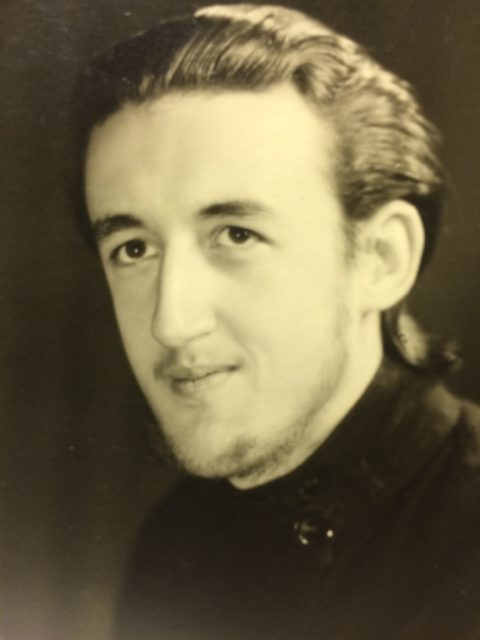 Alexei Georgievich Grabbe, son of count Yurii Pavlovich Grabbe, the future Bishop Gregory and Chancellor to the Synod of Bishops was born on June 22, 1926, in Belgrade. He strove toward God’s service from his youth. At the age of 16, he was an ordained reader. In 1942 young Alexei was ordained to the diaconate and at the age of 22, he received the monastic tonsure. On December 31, 1948, Metropolitan Anastasii tonsured Deacon Alexei into the mantiya, giving him the name Antonii in honor of St. Antonii the Great. The next year Hierodeacon Antonii moved to Holy Trinity Monastery in Jordanville where he entered Holy Trinity Seminary from which he graduated with a bachelor’s degree in theology. Soon he was ordained a hieromonk. That same 1954 year he was made head of St. Sergius School in New York, whose irreplaceable director he remained for almost thirty years. He was able to find support for the school from 44 municipal authorities and attract teachers and students, whose number had increased to 144 by 1958, to its creation and creative work. That same year the school was turned into a fully accredited high school. While head if the high school Fr. Antonii served at the Synodal Church of the Theotokos of the Sign and as secretary for Archbishop Vitalii (Maksimenko). In 1962 he was elevated to the rank of archimandrite, and in 1968 he was appointed director of the Russian Spiritual Mission in Jerusalem. At that point the Mission was having a difficult time, since some of its property had been handed over to the Moscow Patriarchate. Father Antonii managed to win a court trial against the Israeli government, receiving a compensation of seven million dollars for moral damages. Archimandrite Antonii also actively joined the activity of the Orthodox Palestinian Society and was elected Vice-Chairman of its Administrative Bureau in 1969. In 1974 he was granted a gramota of thanks by the Bishops’ Council for diligent work on behalf of the Church’s well-being.
Alexei Georgievich Grabbe, son of count Yurii Pavlovich Grabbe, the future Bishop Gregory and Chancellor to the Synod of Bishops was born on June 22, 1926, in Belgrade. He strove toward God’s service from his youth. At the age of 16, he was an ordained reader. In 1942 young Alexei was ordained to the diaconate and at the age of 22, he received the monastic tonsure. On December 31, 1948, Metropolitan Anastasii tonsured Deacon Alexei into the mantiya, giving him the name Antonii in honor of St. Antonii the Great. The next year Hierodeacon Antonii moved to Holy Trinity Monastery in Jordanville where he entered Holy Trinity Seminary from which he graduated with a bachelor’s degree in theology. Soon he was ordained a hieromonk. That same 1954 year he was made head of St. Sergius School in New York, whose irreplaceable director he remained for almost thirty years. He was able to find support for the school from 44 municipal authorities and attract teachers and students, whose number had increased to 144 by 1958, to its creation and creative work. That same year the school was turned into a fully accredited high school. While head if the high school Fr. Antonii served at the Synodal Church of the Theotokos of the Sign and as secretary for Archbishop Vitalii (Maksimenko). In 1962 he was elevated to the rank of archimandrite, and in 1968 he was appointed director of the Russian Spiritual Mission in Jerusalem. At that point the Mission was having a difficult time, since some of its property had been handed over to the Moscow Patriarchate. Father Antonii managed to win a court trial against the Israeli government, receiving a compensation of seven million dollars for moral damages. Archimandrite Antonii also actively joined the activity of the Orthodox Palestinian Society and was elected Vice-Chairman of its Administrative Bureau in 1969. In 1974 he was granted a gramota of thanks by the Bishops’ Council for diligent work on behalf of the Church’s well-being.
Unfortunately, Archimandrite Antonii’s activity as Director of the Russian Spiritual Mission had its negative aspects as well. This was, in the first place, expressed by his self-willed management of the Mission’s property and finances. It became known in 1985 that the Mission Director had sold a number of its properties to the Israeli Government without the knowledge of church authorities. In September of 1985, at the Bishops’ Council in Monsonville, Canada, following Archimandrite Antonii’s report, a commission was formed, containing their eminences Archbishop Antonii (Sinkevich) of Los Angeles and Southern California, Archbishop Lavr of Syracuse, and Bishop Ilarion of Manhattan to audit the monetary and administrative matters of Mission Director Archimandrite Antonii. The committee worked for three weeks in October and determined that the financial accountability of the Russian Spiritual Mission I Jerusalem was in a chaotic state. The expense record was entirely absent. There were instances of actual embezzlement. Thus, large amounts of church money went directly into Father Antonii’s personal account. A number of deficits were discovered in connection with financial questions and property sales. The January 1986 Bishops’ Council in New York made known a detailed report listing clear violations allowed by Archimandrite Antonii. Based on this report and after lengthy discussion the Council offered Father Antonii to resign as Director of the Russian Spiritual Mission and from his position in the Orthodox Palestinian Society, and on February 3 it relieved him from these duties. At its meeting on March 27, 1986, the Bishops’ Synod continued the investigation of Archimandrite Antonii’s case and issued a resolution with a detailed listing of violations of a whole series of canons and church rules on his part. Soon Archimandrite Antonii was forbidden to serve by Metropolitan Vitalii (Ustinov), and his case was relegated for consideration by the ecclesiastical court. At the same time he was relieved of the position of Director of St. Sergius High School, but, unfortunately, was not dismissed from the Orthodox Palestinian Society. Father Antonii attempted to go over into the Serbian Orthodox Church to Patriarch German. However, in response to the request by the representative of the Serbian Church in the United States Bishop Christopher, the First Hierarch of ROCOR Metropolitan Vitalii responded that the Synod cannot issue a release to Father Antonii while he is under suspension and subject to ecclesiastical court. At the same time the Synod decided to dispatch Father Antonii into Bishop Mark’s disposal as custodian of church property in Wiesbaden. However, Archimandrite Antonii did not comply with the Synod’s decision and did not go to the place of his new assignment. Accusing the leadership of the Russian Church Abroad of bias he transferred to the jurisdiction of the Greek Old Calendar Metropolitan Paisios of the Chrysostom Synod. On September 4, 1986, the Synod of Bishops deprived Archimandrite Antonii of his priesthood for irresponsible squandering of church assets, violation of laws governing the management of the property of others, lack of accountability in the Russian Spiritual Mission in Jerusalem, as well as for his suggestive way of life. Immediately after this decision a split began in the Orthodox Palestinian Society. The backers of Antonii (Grabbe) stopped allowing representatives of the Russian Church Abroad access to the St. Alexander daughter church and to the Church of St. Alexander Nevsky at the Russian excavations. In 1998 the Greek Old Calendar Synod, to which Antonii, who had already been consecrated bishop, belonged, fell apart. In 2001 Antonii was accepted into the so-called Russian Orthodox Autonomous Church (which was headed then by Valentin Rusantsov) as a retired bishop. On September 12, 2005, gravely ill Antonii Grabbe reposed at the age of 79 and was buried at Novo-Diveevo Cemetery.
Archimandrite Mitrofan (Manuilov-Edlinskii)
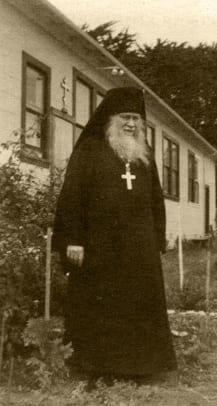 Aleksei Pavlovich Edlinskii was born on March 28, 1900 in the Voronezh province to Priest Pavel and Anna Konstantinovna Manuilov. He graduated from the First Voronezh Gimnaziiz in 1918 and from the Voronezh Agricultural Institute in 1924 with a major in agronomy. He married the daughter of Archpriest M. Tuchnev. During the Second World War he found himself in the emigration. He served as a reader at various parishes in Germany. Archbishop John (Maksimovich) of Brussels and Western Europe was his spiritual father. Widowed in 1953, he followed his confessors advice and was tonsured at St. Job Monastery, taking Mitrofan as his monastic name. The next day Monk Mitrofan was tonsured reader, and on the following day he was ordained hierodeacon. On May 6, 1954, he was ordained hieromonk by Vladyka John (Maksimovich), and on January 14, 1955, was appointed rector of the Church of the Resurrection in Tunis. This church’s construction took two years and was paid for exclusively by the parishioners, who numbered over 250 after the Second World War. Its consecration took place in 1955 with the participation of Archbishop John (Maksimovich) of Brussels and Western Europe, Bishop Leontii (Bartoshevich) of Geneva, and Hieromonk Mitrofan, the parish rector. In 1957 Father Mitrofan was awarded the nabedrennik and a gold pectoral cross. He moved to Paris in 1958, where until 1961 he was assistant to the rector of the Church of All Saints of Russia, while simultaneously serving as religion teacher at the Russian military school in Versailles. On April 1, 1961 he was elevated to the rank of hegumen. In 1964 he immigrated to the United States, and served from October of that year as rector of St. Tikhon Parish in San Francisco. At the same time Archbishop John (Maksimovich) appointed him to the Building Committee of the Cathedral and installed him in 1966 as a member of Cathedral clergy. In 1967 he was elevated to the rank of archimandrite. Having obtained canonical retirement in 1985 he moved to Holy Trinity Monastery in Jordanvillle, where he lived out the last few months of his life. Archimandrite Mitrofan reposed on January 14, 1986, and was buried at the monastery brotherhood cemetery.
Aleksei Pavlovich Edlinskii was born on March 28, 1900 in the Voronezh province to Priest Pavel and Anna Konstantinovna Manuilov. He graduated from the First Voronezh Gimnaziiz in 1918 and from the Voronezh Agricultural Institute in 1924 with a major in agronomy. He married the daughter of Archpriest M. Tuchnev. During the Second World War he found himself in the emigration. He served as a reader at various parishes in Germany. Archbishop John (Maksimovich) of Brussels and Western Europe was his spiritual father. Widowed in 1953, he followed his confessors advice and was tonsured at St. Job Monastery, taking Mitrofan as his monastic name. The next day Monk Mitrofan was tonsured reader, and on the following day he was ordained hierodeacon. On May 6, 1954, he was ordained hieromonk by Vladyka John (Maksimovich), and on January 14, 1955, was appointed rector of the Church of the Resurrection in Tunis. This church’s construction took two years and was paid for exclusively by the parishioners, who numbered over 250 after the Second World War. Its consecration took place in 1955 with the participation of Archbishop John (Maksimovich) of Brussels and Western Europe, Bishop Leontii (Bartoshevich) of Geneva, and Hieromonk Mitrofan, the parish rector. In 1957 Father Mitrofan was awarded the nabedrennik and a gold pectoral cross. He moved to Paris in 1958, where until 1961 he was assistant to the rector of the Church of All Saints of Russia, while simultaneously serving as religion teacher at the Russian military school in Versailles. On April 1, 1961 he was elevated to the rank of hegumen. In 1964 he immigrated to the United States, and served from October of that year as rector of St. Tikhon Parish in San Francisco. At the same time Archbishop John (Maksimovich) appointed him to the Building Committee of the Cathedral and installed him in 1966 as a member of Cathedral clergy. In 1967 he was elevated to the rank of archimandrite. Having obtained canonical retirement in 1985 he moved to Holy Trinity Monastery in Jordanvillle, where he lived out the last few months of his life. Archimandrite Mitrofan reposed on January 14, 1986, and was buried at the monastery brotherhood cemetery.
Hierodeacon Gelasii (Mitusov)
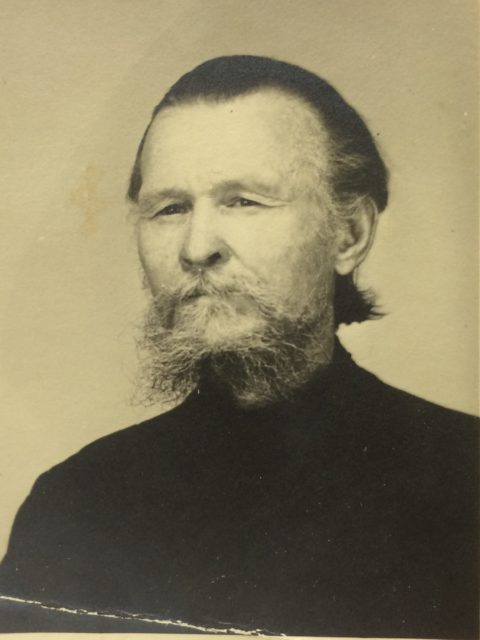 Information on his biography is, unfortunately, extremely scant. We do know that Father Gelasii came from the Don Cossacks and was born on May 15, 1890. He was in Soviet prison for connections with the Catacomb Church. He lost his family during the Second World War and found himself in emigration in Germany. He received monastic tonsure at the Munich Monastery of St. Job and subsequently moved to the United States and entered Holy Trinity Monastery in Jordanville, where he was ordained hierodeacon. His obedience at the monastery was beekeeping. According to those who knew Father Gelasii he worked indefatigably at the monastery. A hereditary Don Cossack, he was flesh from flesh and blood from blood a child of his milieu. He was a harmonic combination of tremendous physical strength, will power, and steadfast devotion to his past. He was rather introverted and didn’t like to talk about himself, but we do know that on his deathbed he disclosed an amazing secret to Priest Mikhail Bylinskii about a miracle that he had experienced. While in Soviet prisons he was at death’s door a number of times. Once, when imminent death threatened him, a certain unfamiliar elder appeared to him and told him to rest easy, since death would pass him by this time and that he would serve God in another place and in another way. Coming to himself, Father Gelasii didn’t see anyone. And so, when he was already in Munich and saw Metropolitan Anastasii for the first time he realized that he was that same elder who returned him to life. Father Gelasii reposed on September 7, 1966, from leukemia and was buried at the Holy Trinity Monastery Cemetery.
Information on his biography is, unfortunately, extremely scant. We do know that Father Gelasii came from the Don Cossacks and was born on May 15, 1890. He was in Soviet prison for connections with the Catacomb Church. He lost his family during the Second World War and found himself in emigration in Germany. He received monastic tonsure at the Munich Monastery of St. Job and subsequently moved to the United States and entered Holy Trinity Monastery in Jordanville, where he was ordained hierodeacon. His obedience at the monastery was beekeeping. According to those who knew Father Gelasii he worked indefatigably at the monastery. A hereditary Don Cossack, he was flesh from flesh and blood from blood a child of his milieu. He was a harmonic combination of tremendous physical strength, will power, and steadfast devotion to his past. He was rather introverted and didn’t like to talk about himself, but we do know that on his deathbed he disclosed an amazing secret to Priest Mikhail Bylinskii about a miracle that he had experienced. While in Soviet prisons he was at death’s door a number of times. Once, when imminent death threatened him, a certain unfamiliar elder appeared to him and told him to rest easy, since death would pass him by this time and that he would serve God in another place and in another way. Coming to himself, Father Gelasii didn’t see anyone. And so, when he was already in Munich and saw Metropolitan Anastasii for the first time he realized that he was that same elder who returned him to life. Father Gelasii reposed on September 7, 1966, from leukemia and was buried at the Holy Trinity Monastery Cemetery.
Monk Nifont (Ershov)
Nikolai Ershov in the world, he was born on December 12, 1879, in Voronezh. From his youth, he pursued military service. He graduated from the military engineering school which was in the Engineers’ Palace in St. Petersburg with a diploma in military engineering. His specialty was the construction of pontoon bridges. He took part in the 1905 Russo-Japanese War for which he was awarded with the Order of St. George and other military awards. After the war’s end as captain he was transferred to Kiev, where he commanded a company in one of the battalions of the sapper troops in Kiev. At the start of the First World War in 1914, he was sent with his battalion to the Galician front. In military service he showed himself to be a model officer of the imperial army. With a well-rounded education he knew the sapper trade. He was an excellent fortificator, a builder of front line bridges, a good mine layer and demolition expert. Father Nifont maintained extraordinary erudition till the end of his life. Pilgrims to Holy Trinity Monastery would note his extensive knowledge in geology, poetry, ornithology, fine art, mathematics, history, archeology, and botany. Already in immigration he had to master raising chickens and the art of cooking. Devoted to the throne and his native land, Nikolai Ershov would fulfill his duty regardless of difficulty and danger. And he faced dangers aplenty. One of the officers in his battalion was killed next to him at the Sana River. Out of the four officers in his company one, whose chest was shot through, was sent to the hospital, while another had a shattered hip. Once, during a dark night in the Carpathian Mountains with an infantry unit he was surrounded and taken prisoner. After that he took part in the Civil War and became shell-shocked. Like many of the participants in the White Movement he was obliged to leave his country, abandon his family, and experience all of the bitterness of immigrant life. In 1938 Nikolai joined the brotherhood of St. Job of Pochaev Monastery in Ladomirovo in the Carpathian Mountains, where he fulfilled various obediences as a worker. During the Second World War, having left the quiet of the monastery he took part in training young sappers of General Vlasov’s Russian Liberation Army. After the end of the Vlasov Movement and the departure of the brotherhood from Ladomirovo Nikolai joined the brotherhood of St. Job of Pochaev in Munich. In 1949 he moved to the United States and entered Holy Trinity Monastery in Jordanville, where he received the monastic tonsure with the name Nifont. In an article devoted to Father Nifont’s memory Archimandrite Konstantin (Zaitsev) notes that having given his entire life to the army Father Nifont remained a soldier beneath the klobuk as well. He was totally a man of Imperial Russia. Not only was he highly educated, he was also a man of culture. This was visibly demonstrated by the fact that he could not exist without newspapers, which was a great help to the editorial staff of Pravoslavnaia Rus’. His major characteristics were discipline, accuracy, precision in everything, and diligence. He acquired these both in cadet school and in military service. The monastery’s inhabitants and pilgrims remember Father Nifont as a nice old man with a thin grey braid tied together by a black lace, a small grey beard, and gentle pensive eyes. His gentleness and sincerity were the very features that attracted people to him. He would love children who would come to Jordanville with a special fatherly love, constantly spending time with them and helping them with math and history, for he knew their needs and troubles. He attended services unfailingly at his spot on the left kliros. He reposed on May 8, 1967 and was buried at the brotherhood cemetery behind the altar of the Holy Trinity Monastery Church
Hierodeacon Varlaam (Nahai)
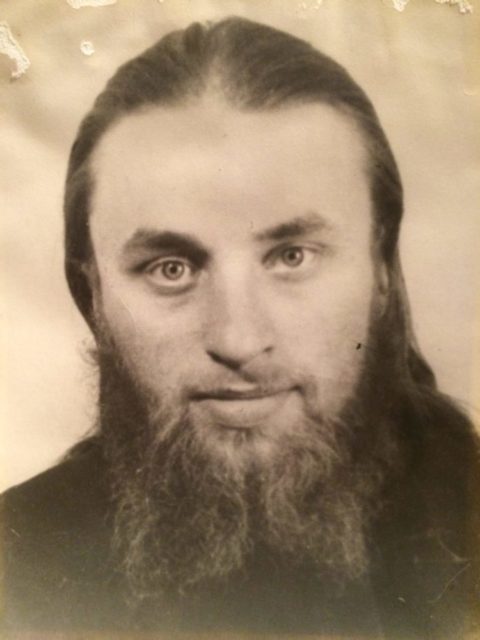 Vasilii Nahai was born in Belarus. During the Second World War he found himself in occupied territory, took part in military action, and was wounded. Finding himself in Munich, he entered the Monastery of St. Job, where he was under Father Gelasii’s obedience. Later, Vasilii went to the United States, where he joined the brotherhood of Holy Trinity Monastery and received monastic tonsure. Also in Jordanville he graduated from Holy Trinity Seminary. His constant obedience was work in the printing press. In addition, he was the monastery driver and boiler man, maintaining the furnace in the old residential house. With his good bass voice he sang in the choir. He was attentive, diligent, and kindly. Those who knew him note such qualities as simplicity, humility, soft facial features, a voice with gentle nuances, and, at the same time, enormous physical strength. Children and teenagers who visited the monastery, including our current protodeacon, Father Victor Lokhmatov, loved Father Varlaam and obeyed him without question. His basic feature was kindness. In the words of Father Constantin (Zaitsev) he would melt down with kindness when dealing with people, ready to give of himself and everything he had to each person, and to be a brother to each one. He was diligent and conscientious in fulfilling the obediences that were laid upon him. And it was while fulfilling obedience that he perished tragically in the winter of 1958 when a beam fell on him as he was plowing snow on a tractor around the monastery. Father Varlaam’s burial was the first one in the brotherhood cemetery behind the altar of Holy Trinity Church. It was after his death that the decision was made at an emergency spiritual council to devote this area behind the church for members of the monastic brotherhood.
Vasilii Nahai was born in Belarus. During the Second World War he found himself in occupied territory, took part in military action, and was wounded. Finding himself in Munich, he entered the Monastery of St. Job, where he was under Father Gelasii’s obedience. Later, Vasilii went to the United States, where he joined the brotherhood of Holy Trinity Monastery and received monastic tonsure. Also in Jordanville he graduated from Holy Trinity Seminary. His constant obedience was work in the printing press. In addition, he was the monastery driver and boiler man, maintaining the furnace in the old residential house. With his good bass voice he sang in the choir. He was attentive, diligent, and kindly. Those who knew him note such qualities as simplicity, humility, soft facial features, a voice with gentle nuances, and, at the same time, enormous physical strength. Children and teenagers who visited the monastery, including our current protodeacon, Father Victor Lokhmatov, loved Father Varlaam and obeyed him without question. His basic feature was kindness. In the words of Father Constantin (Zaitsev) he would melt down with kindness when dealing with people, ready to give of himself and everything he had to each person, and to be a brother to each one. He was diligent and conscientious in fulfilling the obediences that were laid upon him. And it was while fulfilling obedience that he perished tragically in the winter of 1958 when a beam fell on him as he was plowing snow on a tractor around the monastery. Father Varlaam’s burial was the first one in the brotherhood cemetery behind the altar of Holy Trinity Church. It was after his death that the decision was made at an emergency spiritual council to devote this area behind the church for members of the monastic brotherhood.
Viktor Nikolaevich Shevtsov
He took part in the White Movement and immigrated along with White Army units. He then lived in Yugoslavia where he was favored by King Alexander and served under him, fulfilling many iconographic assignments. He worked in various ancient monasteries as well as in the royal chapel and burial vault. He went to Munich during the Second World War and moved to the United States in 1949. He took part in the initial stages of the frescoing of the upper church of Holy Trinity Monastery. He spent his last years in Buffalo, in the western part of New York State, where he fulfilled portrait orders and gave art lessons. In 1953 his ailing heart and eyes caused him to abandon art. He reposed on July 27, 1957, in Buffalo.
Conclusion
The subject that was examined in our report undoubtedly requires further research. We were not able to discover material neither on Hegumen Ioasaf (Ryzhko), nor on Hieromonk Varnava [4]His tombstone indicates that he was born on February 19, 1897, and died on March 24, 1974. See also Nekropol’ Sviato-Troitskogo monastyria v Zhordanville [Necropolis of The Holy Trinity Monastery … Continue reading (Andreev). For now there are no biographies of Novices Fiodor (Evtushenko), Foma (Ponovnichenko), and Daniil (Petrenko). [5]All we know about him is that Daniil Viktorovich Petrenko was born in the Kuban Region on December 15, 1905, and reposed on May 9, 1990. See Nekropol’ Sviato-Troitskogo monastyria v Dzhordanville … Continue reading We hope that in the future we will have information on all of the inhabitants of the Monastery of St. Job in Munich who continued their service at Holy Trinity Monastery.
The monks of the Monastery of St. Job left their monastery and set off on a long journey not in search of earthly blessings, but as a fulfillment of their monastic obedience. It is important to emphasize that this became possible thanks to the fact that the Church, being a conciliar organism, sends its servers wherever their help is most needed and where they can display their abilities for the good of church service with maximum benefit.
To sum up we can boldly say that their role in church life was particularly positive. Whether in a lofty hierarchical rank or in monastery obediences, all of them labored as much as they could for the good of Holy Orthodoxy and for our Russian Church Abroad.
Translated into English by Priestmonk Alexis (Lisenko)
Sources
Pravoslavnaia Rus’ [Orthodox Russia]:
1949:4, p. 15. “Ot’ezd semi sobratii podvoriia prep. Iova Pochaevskogo v Miunkhene v Ameriku” [The Departure of Seven Brethren of the Monastery of St. Job of Pochaev in Munich to America].
1949:7-8, pp.13, 16. “Slovo, proiznesionnoe mitropolitom Anastasiem pri postrizhenii v monashestvo Antoniia (Grabbe) [Metropolitan Anastassii’s Message at the Monastic Tonsure of Antonii (Grabbe].”
1956:9, p. 15 “Nagrady i povysheniia [Awards and Elevations].”
1956:22, p. 13 “Episkop Serafim Karakasskii I Venesuiel’skii v Sv. Troitskom monastyre” [Bishop Serafim of Caracas and Venezuela at Holy Trinity Monastery].
1957:5, p. 14 “Khirotoniia arkhimandrita Serafima” [The Consecration of Archimandrite Serafim].
1957:9, p. 14 Zholtkevich, Flor port. “Privetstvennoe slovo prot. Flora Zholkevicha episkopu Serafimu” [Archpriest Flor Zholtkevich’s Welcoming Message to Bishop Serafim].
1957:9, p. 16 “Episkop Serafim v Venetsuele” [Bishop Serafim is in Venezuela].
1957:15, p. 15 “Konchina khudozhnika Shevtsova V. N.” [Repose of artist V. N Shevtsov].
1958:2, pp. 7-8 Konstantin arkhim. (Zaitsev). “Tikhii angel proletel…” [Archimandrite Konstantin (Zaitsev) A Quiet Angel Flew By…].
1958:2, p. 15 “Poslednie provody o. ierodiakona Varlaama” [Hierodeacon Varlaam’s Final Send-off].
1958:11, p.14 “Prestol’nyi prazdnik Sv. Troitskogo monastyria” [The Altar Feast of Holy Trinity Monastery].
1962:7, p. 13 “Nagrazhdenie delatelei Sv. Troitskogo monastyria” [The Awarding of Notables at Holy Trinity Monastery].
1966:17, pp. 4-5 “Konchina ierodiakona Gelasiia” [Repose of Hierodeacon Gelasii].
1967:9, p. 10 Konstantin arkhim. (Zaitsev) “Pamiati otsa Nifonta” [Archimandrite Konstantin (Zaitsev) In Memory of Father Nifont].
1967:10, pp. 5-6 G. Deinitsyna G. i O. K. “Svetloi pamiati otsa Nifonta” [In Blessed Memory of Father Nifont].
1970:14, p. 14 “Bolezn’ arkhiepiskopa Serafima Brazil’skogo” [The Illness of Archbishop Serafim of Brazil].
1972:21, p. 5 Filaret mitr. “Soobshchenie po povodu sdachi v arendu nekotorykh uchastkov na Sviatoi Zemle” [Metropolitan Filaret, “A Notice Regarding the Rental of Certain Properties in the Holy Land”].
1976:14, p. 14 Lirika, V, O, “Arkhiepiskop Serafim, v Rio de Zhaneiro” [V. O, Lirika, “Archbishop Serafim is in Rio de Janeiro”].
1976:16, p. 4 “Slovo preosviashchennogo Serafima, arkhiepiskopa San-Paul’skogo i Brazil’sko-Venesuel’skogo, skazannoe v Sviato-Troitskom monastyre 26.iiulia/8 avgusta 1976 g.” [“Message of His Eminence Serafim, Archbishop of Sao Paulo, Brazil, and Venezuela, delivered on July 26/August 8, 1976 at Holy Trinity Monastery”].
1977:19, p. 14 Prikhozhanin. “Proshchanie arkhiepiskopa Serafima so svoei Brazil’skoi pastvoi {A Parishioner. Archbishop Serafim’s Farewell to His Brazil Flock].”
1986:15, pp. 3, 16 “Zaiavlenie kantseliarii Arkhireiskogo Sinoda (delo arkhim. Antoniia Grabbe)” “[Statement by the Office of the Bishops’ Synod (In the Matter of Archimandrite Antonii Grabbe)].”
1986:18, PP. 3-4 “Opredelenie Arkhiereiskogo Sinoda Russkoi Pravoslavnoi Tserkvi Zagranisei 22 avgusta/4 sentiabria 1986 g. (delo Antoniia Grabbe)” [“Decision of the Bishops’ Synod of the Russian Orthodox Church Outside Russia of August 22/September 4, 1986 (in the matter of Antonii Grabbe)”].
1988:16, pp. 14-15 “Pamiati archimadrita Vladimira” [“In Memory of Archimandrite Vladimir”].
1988:16, pp. 15-16 Tarasevich Moisei port. “Pamiati pochivshego druga i sobrata vo Khriste sviashchenoarkhimandrita Vladimira (Sukhobok).” [“In Memory of a Friend and Fellow Brother the Holy Archimadrite Vladimir (Sukhobok)”].
1989:13, pp. 2-3 Luk’ianov Valerii port. “Svetloi pamiati druga. Venok na svezhuiu mogilu arkhimandrita Vladimira” [“In Blessed Memory of a Friend. A Wreath on the Fresh Grave of Arcimandrite Vladimir”].
1992:18, p. 23 Serafim arkhiepiskop (Svezhevskii) “Khristianskii put’ “[“The Christian Path”].
1993:15, pp. 1-2 Serafim arkhiepiskop (Svezhevskii) “O delanii khristianskom” [“On Christian Activity”].
Sollogub, A. A. Russkaia Pravoslavnaia Tserkov’ Zagranitsei, 1918-1968. Izdatel’stvo Russkoi Dukhovnoi Missii v Ierusalime t. II s. 934-945 [The Russian Orthodox Church Outside Russia, 1918-1968, Published by Russian Spiritual Mission in Jerusalem].
Kuznetsov, V. A. Russkoe pravoslavnoe zarubezhnoe monashestvo v XX veke. Ekaterinburg, 2015, s. 98, 105, 295 [Russian Orthodox Monasticism Abroad]
References
| ↵1 | A.A. Sollogub, Russkaia Pravoslavnaia Tserkov’ Zagranitsei [The Russian Orthodox Church Outside Russia, 1918-1968]. Russian Spiritual Mission in Jerusalem. |
|---|---|
| ↵2 | Pravoslavnaia Rus’ [Orthodox Russia] 1949:4, p. 15. |
| ↵3 | All dates are according to the new calendar. |
| ↵4 | His tombstone indicates that he was born on February 19, 1897, and died on March 24, 1974. See also Nekropol’ Sviato-Troitskogo monastyria v Zhordanville [Necropolis of The Holy Trinity Monastery in Jordanville], p. 33. |
| ↵5 | All we know about him is that Daniil Viktorovich Petrenko was born in the Kuban Region on December 15, 1905, and reposed on May 9, 1990. See Nekropol’ Sviato-Troitskogo monastyria v Dzhordanville [Necropolis of The Holy Trinity Monastery in Jordanville], p. 142. |

